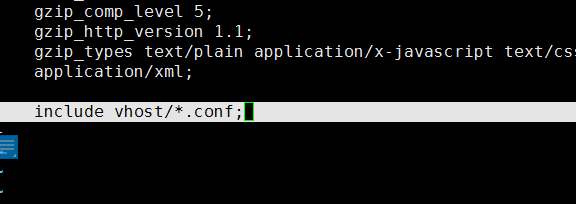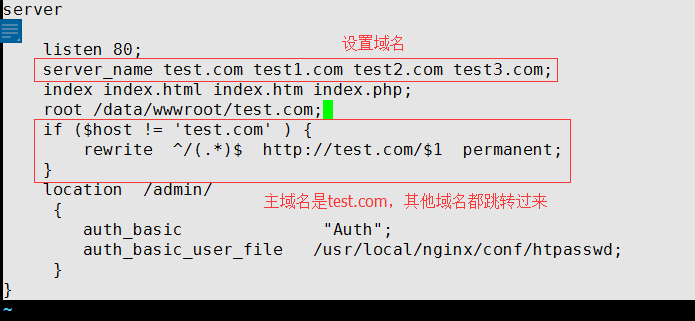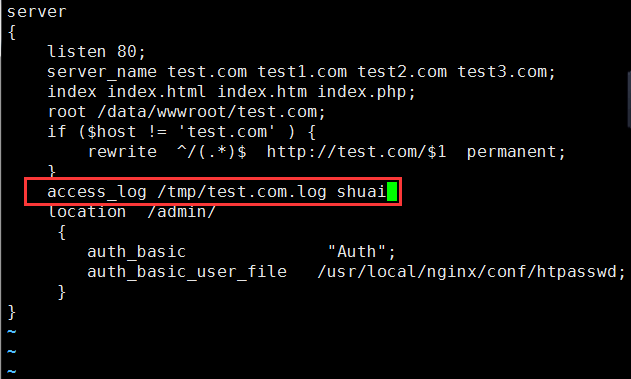Nginx默认虚拟主机,Nginx用户认证,Nginx重定向,Nginx访问日志,Nginx防盗链,Nginx访问控制,Nginx解析PHP
nginx默认虚拟主机
设置Nginx默认虚拟主机,其实默认就设置了。在Nginx的配置文件中,直接添加server就是,一般的,你有几个网站就设置几个server。还有另一种设置方式,在配置文件中不要去设置server,直接重新写一个虚拟主机配置文件(vhost/*.conf).,在配置文件中加上include vhost/ *.conf
编辑配置文件,把Nginx配置文件中server段删去,添加一段:
include vhost/*.conf;
在/usr/local/nginx/conf/目录下,创建一个目录(vhost),并在目录下创建一个新文件。这个vhost就类似于Apache中的虚拟配置文件。
[root@shuai-01 conf]# mkdir vhost
[root@shuai-01 conf]# cd vhost/
[root@shuai-01 vhost]# ls
[root@shuai-01 vhost]# vim aaa.com.conf
server
{
listen 80 default_server; // 有这个标记的就是默认虚拟主机
server_name aaa.com;
index index.html index.htm index.php;
root /data/wwwroot/default;
}
创建/data/wwwroot/default,并在defualt目录下编写index.html文件:
[root@shuai-01 vhost]# mkdir /data/wwwroot/default
[root@shuai-01 vhost]# cd /data/wwwroot/default/
[root@shuai-01 default]# vim index.html
echo “This is a default site.”>/data/wwwroot/default/index.html
检测一下配置文件语法
[root@shuai-01 default]# /usr/local/nginx/sbin/nginx -t
nginx: the configuration file /usr/local/nginx/conf/nginx.conf syntax is ok
nginx: configuration file /usr/local/nginx/conf/nginx.conf test is successful
重新加载配置文件:
[root@shuai-01 default]# /usr/local/nginx/sbin/nginx -s reload
一般的,在服务器跑动的时候,都选择重新加载配置文件,而不是重启服务(/etc/init.d/nginx restart),重启服务会短暂关闭然后在启动。
测试默认主机:
[root@shuai-01 default]# curl localhost
this is a default site
默认虚拟主机就是只要你解析过来是这个IP,不管什么域名,都会访问到默认虚拟主机。
[root@shuai-01 default]# curl -x127.0.0.1:80 bbb.com
this is a default site
[root@shuai-01 default]# curl -x127.0.0.1:80 abadsj.com
this is a default site
Nginx用户认证
做用户认证就是为了安全,在做httpd的用户认证时就已经说到过,可以将两篇帖子结合起来看。
http://blog.csdn.net/aoli_shuai/article/details/78854280
用户认证步骤:
- 确认机器安装过htpasswd命令(httpd的)
- 没安装htpaswdd安装后,在server中加上配置location,那些站点,目录,页面需要用户认证,密码文件的存放
- 通过命令为用户设置密码 /usr/local/apache2.4/bin/htpasswd -c /usr/local/nginx/conf/htpasswd shuai
创建一个虚拟主机(test.com.conf):
[root@shuai-01 wwwroot]# cd /usr/local/nginx/conf/vhost/
[root@shuai-01 vhost]# ls
aaa.com.conf
[root@shuai-01 vhost]# vim test.com.conf
写入:
server
{
listen 80;
server_name test.com;
index index.html index.htm index.php;
root /data/wwwroot/test.com;
location /
{
auth_basic "Auth";
auth_basic_user_file /usr/local/nginx/conf/htpasswd;//用户名密码文件
}
}
生成密码的工具是htpasswd,这个工具在Apache用户认证时就安装过了,没安装的就用yum install -y httpd 安装上。
为shuai用户做用户认证:
[root@shuai-01 vhost]# /usr/local/apache2.4/bin/htpasswd -c /usr/local/nginx/conf/htpasswd shuai
New password:
Re-type new password:
Adding password for user shuai
为aoli用户做认证:
[root@shuai-01 vhost]# /usr/local/apache2.4/bin/htpasswd /usr/local/nginx/conf/htpasswd aoli
New password:
Re-type new password:
Adding password for user aoli
[root@shuai-01 vhost]# cat /usr/local/nginx/conf/htpasswd
shuai:$apr1$V0AiFAbc$CSttuCLed5mA1AMi1mKdw/
aoli:$apr1$OX2YLAuw$z1XF5XGLO/Z15Qw5dFo0V0
检查配置文件语法并重新加载配置文件:
[root@shuai-01 vhost]# /usr/local/nginx/sbin/nginx -t
nginx: the configuration file /usr/local/nginx/conf/nginx.conf syntax is ok
nginx: configuration file /usr/local/nginx/conf/nginx.conf test is successful
[root@shuai-01 vhost]# /usr/local/nginx/sbin/nginx -s reload
测试:
[root@shuai-01 vhost]# curl -x127.0.0.1:80 test.com
401 Authorization Required
401 Authorization Required
nginx/1.12.2
出现401,需要用户认证。
[root@shuai-01 vhost]# curl -ushuai:123456 -x127.0.0.1:80 test.com
404 Not Found
404 Not Found
nginx/1.12.2
出现404,没有文件。
写一个index.html文件。
[root@shuai-01 vhost]# mkdir /data/wwwroot/test.com
[root@shuai-01 vhost]# echo "test.com" > /data/wwwroot/test.com/index.html
[root@shuai-01 vhost]# curl -ushuai:123456 -x127.0.0.1:80 test.com
test.com
这个用户认证时针对整个站点,只针对某个特定目录的用户认证。针对admin目录。
修改虚拟配置文件:
server
{
listen 80;
server_name test.com;
index index.html index.htm index.php;
root /data/wwwroot/test.com;
location /admin/
{
auth_basic "Auth";
auth_basic_user_file /usr/local/nginx/conf/htpasswd;
}
}
检查配置文件语法并重新加载配置文件:
[root@shuai-01 vhost]# /usr/local/nginx/sbin/nginx -t
nginx: the configuration file /usr/local/nginx/conf/nginx.conf syntax is ok
nginx: configuration file /usr/local/nginx/conf/nginx.conf test is successful
[root@shuai-01 vhost]# /usr/local/nginx/sbin/nginx -s reload
测试:
访问test.com
[root@shuai-01 vhost]# curl -x127.0.0.1:80 test.com
test.com
访问test.com/admin
[root@shuai-01 vhost]# curl -x127.0.0.1:80 test.com/admin
404 Not Found
404 Not Found
nginx/1.12.2
针对某个.php文件
配置文件写成
location ~ admin.php
nginx域名重定向
域名重定向是主机设置多个域名,将访问的请求不是主域名的定向到主域名去
域名重定向步骤
- server_name中设置多个域名
- 配置文件中加上规则
更改虚拟配置文件
[root@shuai-01 vhost]# vim test.com.conf
server
{
listen 80;
server_name test.com test1.com test2.com test3.com;
index index.html index.htm index.php;
root /data/wwwroot/test.com;
if ($host != 'test.com' ) {
rewrite ^/(.*)$ http://test.com/$1 permanent;
}
location /admin/
{
auth_basic "Auth";
auth_basic_user_file /usr/local/nginx/conf/htpasswd;
}
}
这里多个域名都可以写到server_name 后面,不像httpd,有server_alias .
这里的permanent表示301跳转。
redirect 表示302
检查配置文件语法并重新加载配置文件:
[root@shuai-01 vhost]# /usr/local/nginx/sbin/nginx -t
nginx: the configuration file /usr/local/nginx/conf/nginx.conf syntax is ok
nginx: configuration file /usr/local/nginx/conf/nginx.conf test is successful
[root@shuai-01 vhost]# /usr/local/nginx/sbin/nginx -s reload
测试:
[root@shuai-01 vhost]# curl -x127.0.0.1:80 test2.com/index.html -I
HTTP/1.1 301 Moved Permanently
Server: nginx/1.12.2
Date: Mon, 08 Jan 2018 11:16:30 GMT
Content-Type: text/html
Content-Length: 185
Connection: keep-alive
Location: http://test.com/index.html
[root@shuai-01 vhost]# curl -x127.0.0.1:80 test3.com/index.html -I
HTTP/1.1 301 Moved Permanently
Server: nginx/1.12.2
Date: Mon, 08 Jan 2018 11:16:42 GMT
Content-Type: text/html
Content-Length: 185
Connection: keep-alive
Location: http://test.com/index.html
[root@shuai-01 vhost]# curl -x127.0.0.1:80 test4.com/index.html -I
HTTP/1.1 200 OK
Server: nginx/1.12.2
Date: Mon, 08 Jan 2018 11:16:49 GMT
Content-Type: text/html
Content-Length: 23
Last-Modified: Mon, 08 Jan 2018 07:52:14 GMT
Connection: keep-alive
ETag: "5a53232e-17"
Accept-Ranges: bytes
测试test2.com test3.com 都是301重定向,test4.com 时,访问就是默认虚拟主机。
nginx rewrite四种flag http://www.netingcn.com/nginx-rewrite-flag.html
Nginx的访问日志
Nginx的日志格式是在Nginx的主配置文件中(/usr/local/nginx/conf/nginx.conf)
[root@shuai-01 vhost]# vim /usr/local/nginx/conf/nginx.conf
可以将日志格式名称改一下,改为shaui
Nginx日志字段的含义
在主配置文件中定义日志的格式,在虚拟主机配置文件中定义日志路径。
打开虚拟主机配置文件
[root@shuai-01 vhost]# vim test.com.conf
access_log /tmp/test.com.log shuai;
检查配置文件语法并重新加载配置文件
[root@shuai-01 vhost]# /usr/local/nginx/sbin/nginx -t
nginx: the configuration file /usr/local/nginx/conf/nginx.conf syntax is ok
nginx: configuration file /usr/local/nginx/conf/nginx.conf test is successful
[root@shuai-01 vhost]# /usr/local/nginx/sbin/nginx -s reload
检测:
[root@shuai-01 vhost]# curl -x127.0.0.1:80 test2.com/index.html -I
HTTP/1.1 301 Moved Permanently
Server: nginx/1.12.2
Date: Mon, 08 Jan 2018 12:41:20 GMT
Content-Type: text/html
Content-Length: 185
Connection: keep-alive
Location: http://test.com/index.html
[root@shuai-01 vhost]# curl -x127.0.0.1:80 test3.com/index.html -I
HTTP/1.1 301 Moved Permanently
Server: nginx/1.12.2
Date: Mon, 08 Jan 2018 12:41:26 GMT
Content-Type: text/html
Content-Length: 185
Connection: keep-alive
Location: http://test.com/index.html
[root@shuai-01 vhost]# cat /tmp/test.com.log
127.0.0.1 - [08/Jan/2018:20:41:20 +0800] test2.com "/index.html" 301 "-" "curl/7.29.0"
127.0.0.1 - [08/Jan/2018:20:41:26 +0800] test3.com "/index.html" 301 "-" "curl/7.29.0"
Nginx日志切割
nginx由于没有自带的日志切割工具,在切割日志时,需要借助于系统带的日志切割工具,或者是自己写一个日志切割脚本。
自己写一个日志切割脚本。脚本统一保存/usr/local/sbin/
先自定义一个脚本:
[root@shuai-01 vhost]# vim /usr/local/sbin/nginx_logrotate.sh
#! /bin/bash
## 假设nginx的日志存放路径为/tmp/
d=`date -d "-1 day" +%Y%m%d`
#定义切割时间(切割一天前的日志)
logdir="/tmp/"
#此处指定要切割的日志路径(该路径来自虚拟主机配置文件)
nginx_pid="/usr/local/nginx/logs/nginx.pid"
#调用pid的目的是执行命令:/bin/kill -HUP `cat $nginx_pid`
#该命令等价于命令:nginx -s reload(重新加载文件),确保与虚拟主机配置文件变更保持同步
#该地址来自nginx配置文件
cd $logdir
for log in `ls *.log`
do
mv $log $log-$d
done
#此处使用通配进行循环,并改名字(切割是每天产生的日志重命名)
/bin/kill -HUP `cat $nginx_pid`
#执行此命令进行重载生成新的日志文件来记录新的日志
执行脚本:
[root@shuai-01 vhost]# sh -x /usr/local/sbin/nginx_logrotate.sh
++ date -d '-1 day' +%Y%m%d
+ d=20180108
+ logdir=/tmp/
+ nginx_pid=/usr/local/nginx/logs/nginx.pid
+ cd /tmp/
++ ls test.com.log
+ for log in '`ls *.log`'
+ mv test.com.log test.com.log-20180108
++ cat /usr/local/nginx/logs/nginx.pid
+ /bin/kill -HUP 1513
-x : 作用是显示脚本执行过程
注意:
这只是对日志进行了切割,对日志进行删除需要结合任务计划cron使用。切割也得配合cron使用。
切割之后,将大于一个月的日志文件删除:
[root@shuaiaoli test.log]# find /usr/local/nginx/logs/test.log/ -type f -name *.log-* -mtime +30 |xargs rm
静态文件不记录日志和过期时间
在配置文件中加上配置:
打开配置文件:
location ~ .*\.(gif|jpg|jpeg|png|bmp|swf)$
{
expires 7d;
access_log off;
}
location ~.*\.(js|css)$
{
expires 12h;
acces_log off;
}
[root@shuai-01 vhost]# vim test.com.conf
location ~ .*\.(gif|jpg|jpeg|png|bmp|swf)$
#匹配文件类型
{
expires 7d;
#过期时间为7天
access_log off;
#不记录该类型文件的访问日志
}
location ~ .*\.(js|css)$
{
expires 12h;
#过期时间为12小时
access_log off;
#不记录该类型文件的访问日志
}
检查配置文件语法并重新加载配置文件:
[root@shuai-01 vhost]# /usr/local/nginx/sbin/nginx -t
nginx: the configuration file /usr/local/nginx/conf/nginx.conf syntax is ok
nginx: configuration file /usr/local/nginx/conf/nginx.conf test is successful
[root@shuai-01 vhost]# /usr/local/nginx/sbin/nginx -s reload
测试:
[root@shuai-01 test.com]# curl -x127.0.0.1:80 test.com/1.gif
shjdkjhkasb
[root@shuai-01 test.com]# curl -x127.0.0.1:80 test.com/2.js
ajkfdchb
[root@shuai-01 test.com]# curl -x127.0.0.1:80 test.com/index.html
test.com
[root@shuai-01 test.com]# cat /tmp/test.com.log
127.0.0.1 - [09/Jan/2018:00:39:45 +0800] test.com "/index.html" 200 "-" "curl/7.29.0"
Nginx防盗链
Nginx防盗链也是使用location板块,和不记录静态文件和过期时间写在一起。
防盗链的步骤:
- 设置referer白名单
- 将不是白名单的referer全部拒绝
打开虚拟主机配置文件
[root@shuai-01 ~]# vim /usr/local/nginx/conf/vhost/test.com.conf
location ~* ^.+\.(gif|jpg|png|swf|flv|rar|zip|doc|pdf|gz|bz2|jpeg|bmp|xls)$
{
expires 7d;
valid_referers none blocked server_names *.test.com ;
#定义白名单
if ($invalid_referer) {
return 403;
}
#不是白名单的referer ,返回403
access_log off;
}
注意:location ~* ^.+.这里匹配到的后面的内容是不区分大小写。
测查配置文件语法并重新加载:
[root@shuai-01 ~]# /usr/local/nginx/sbin/nginx -t
nginx: the configuration file /usr/local/nginx/conf/nginx.conf syntax is ok
nginx: configuration file /usr/local/nginx/conf/nginx.conf test is successful
[root@shuai-01 ~]# /usr/local/nginx/sbin/nginx -s reload
测试:
[root@shuai-01 ~]# curl -e "http://www.qq.com/1.txt" -x127.0.0.1:80 -I test.com/1.gif
HTTP/1.1 403 Forbidden
Server: nginx/1.12.2
Date: Tue, 09 Jan 2018 11:00:19 GMT
Content-Type: text/html
Content-Length: 169
Connection: keep-alive
[root@shuai-01 ~]# curl -e "http://www.test.com/1.txt" -x127.0.0.1:80 -I test.com/1.gif
HTTP/1.1 200 OK
Server: nginx/1.12.2
Date: Tue, 09 Jan 2018 11:01:15 GMT
Content-Type: image/gif
Content-Length: 12
Last-Modified: Mon, 08 Jan 2018 16:38:47 GMT
Connection: keep-alive
ETag: "5a539e97-c"
Expires: Tue, 16 Jan 2018 11:01:15 GMT
Cache-Control: max-age=604800
Accept-Ranges: bytes
Nginx的访问控制
关于做防盗链和访问控制的原因我在httpd做访问控制和防盗链时已经说得比较清楚了。
http://blog.csdn.net/aoli_shuai/article/details/78895746
访问控制的步骤:
- 设置IP白名单
需求:访问/admin/目录,只允许那几个IP进行访问。
打开虚拟主机配置文件
location /admin/
{
allow 127.0.0.1;
allow 192.168.176.135;
deny all;
}

这里Nginx设置访问控制和Apache是有很大的不同,关于这个allow,deny。Apache是有一个顺序的,Nginx没有。
测查配置文件语法并重新加载:
[root@shuai-01 ~]# /usr/local/nginx/sbin/nginx -t
nginx: the configuration file /usr/local/nginx/conf/nginx.conf syntax is ok
nginx: configuration file /usr/local/nginx/conf/nginx.conf test is successful
[root@shuai-01 ~]# /usr/local/nginx/sbin/nginx -s reload
检测:
[root@shuai-01 ~]# curl -e "http://www.test.com/1.txt" -x127.0.0.1:80 -I test.com/admin/
HTTP/1.1 200 OK
Server: nginx/1.12.2
Date: Tue, 09 Jan 2018 11:23:23 GMT
Content-Type: text/html
Content-Length: 5
Last-Modified: Tue, 09 Jan 2018 11:23:20 GMT
Connection: keep-alive
ETag: "5a54a628-5"
Accept-Ranges: bytes
[root@shuai-01 ~]# curl -x192.168.176.135:80 test.com/admin/ -I
HTTP/1.1 200 OK
Server: nginx/1.12.2
Date: Tue, 09 Jan 2018 11:25:02 GMT
Content-Type: text/html
Content-Length: 5
Last-Modified: Tue, 09 Jan 2018 11:23:20 GMT
Connection: keep-alive
ETag: "5a54a628-5"
Accept-Ranges: bytes
针对PHP解析做的访问控制(不让用户传上来的PHP文件做解析):
location ~ .*(abc|image)/.*\.php$
{
deny all;
}
针对user_agent进行限制:
if ($http_user_agent ~ 'Spider/3.0|YoudaoBot|Tomato')
{
return 403;
}
return 403 和deny all 效果是一样的。
Nginx解析PHP的相关配置
核心配置:
location ~ \.php$
{
include fastcgi_params;
fastcgi_pass unix:/tmp/php-fcgi.sock;
# fastcgi_pass 127.0.0.1:9000; 如果php-fpm配置监听配置的是IP就写这个
fastcgi_index index.php;
fastcgi_param SCRIPT_FILENAME /data/wwwroot/test.com$fastcgi_script_name;
}
Nginx要想解析PHP就要将这段核心配置写入配置文件中去。
fastcgi_pass 用来指定php-fpm监听的地址或者socket
如果是用的sock那么一定要放开php配置中的listen.mode=666(sock的权限位一定要有写的权限)
unix:/tmp/php-fcgi.sock这里的sock文件是php-fpm.conf中定义的
cat /usr/local/php-fpm/etc/php-fpm.conf配置文件中写什么就定义什么
如果php监听的是ip和端口,nginx中的配置文件就要改成
fastcgi_pass 127.0.0.1:9000;
fastcgi_param 中的路径也需要跟上面对应起来
Nginx502问题出现及解决方法:










